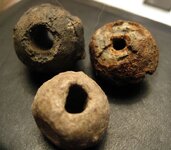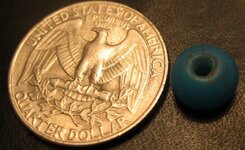BioProfessor
Silver Member
A What is it and Why is it - I just don't get it
I have been hunting a place that has REALLY weird soil. It is a very old site - 17th century - for us on this side of the pond. I dig musket balls in certain areas and they are coated with a brown almost rusty surface. Underneath, they have the "correct" smooth and tan patina. Most have been holed to use as fishing sinkers or seine weights.
There are, however, some that just make no sense. I know there was a house/building that burned in the area but lead usually just melts and I find rough blobs. But I am finding ones in this site - not in the burn area - and the lead is very brittle and crumbles when I try to clean off the crud. Brittle lead? I don't get it.
Any help understanding this would be greatly appreciated.
Thanks,
Daryl
I have been hunting a place that has REALLY weird soil. It is a very old site - 17th century - for us on this side of the pond. I dig musket balls in certain areas and they are coated with a brown almost rusty surface. Underneath, they have the "correct" smooth and tan patina. Most have been holed to use as fishing sinkers or seine weights.
There are, however, some that just make no sense. I know there was a house/building that burned in the area but lead usually just melts and I find rough blobs. But I am finding ones in this site - not in the burn area - and the lead is very brittle and crumbles when I try to clean off the crud. Brittle lead? I don't get it.
Any help understanding this would be greatly appreciated.
Thanks,
Daryl






